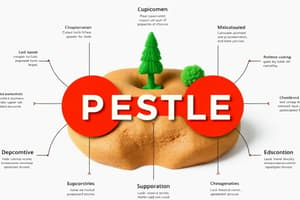Podcast
Questions and Answers
Which of the following scenarios best illustrates the impact of sociocultural factors on a firm's strategic decisions?
Which of the following scenarios best illustrates the impact of sociocultural factors on a firm's strategic decisions?
- A food company reformulating its products to meet the growing demand for healthier options due to increased health consciousness. (correct)
- A construction company adjusting its practices to comply with new environmental regulations.
- A company launching a fuel-efficient car in response to rising oil prices.
- A software firm investing heavily in R&D to stay ahead of technological advancements.
A rise in interest rates would most likely have which of the following effects on a company's strategic decisions?
A rise in interest rates would most likely have which of the following effects on a company's strategic decisions?
- Increased investment in research and development.
- Reduced focus on cost-cutting measures.
- Increased spending on marketing and advertising.
- Reduced investment in capital-intensive projects. (correct)
How might the bargaining power of suppliers impact a company's profitability?
How might the bargaining power of suppliers impact a company's profitability?
- Supplier power has no direct impact on a company's profitability.
- High supplier power increases profitability by encouraging companies to innovate.
- High supplier power can reduce profitability if suppliers charge higher prices or reduce the quality of inputs. (correct)
- High supplier power always leads to increased profitability due to higher quality inputs.
Which of the following scenarios indicates a high threat of new entrants in an industry?
Which of the following scenarios indicates a high threat of new entrants in an industry?
In which of the following situations is competitive rivalry likely to be most intense?
In which of the following situations is competitive rivalry likely to be most intense?
How do complementary products or services affect a firm's strategic decisions?
How do complementary products or services affect a firm's strategic decisions?
Which of the following is the MOST direct way that technology diffusion rates affect strategic decision-making?
Which of the following is the MOST direct way that technology diffusion rates affect strategic decision-making?
What impact would stringent data protection laws MOST likely have on a company specializing in targeted online advertising?
What impact would stringent data protection laws MOST likely have on a company specializing in targeted online advertising?
Which scenario illustrates how ecological factors can create opportunities for business innovation?
Which scenario illustrates how ecological factors can create opportunities for business innovation?
In the context of industry analysis, what are strategic groups?
In the context of industry analysis, what are strategic groups?
Scenario: A country imposes new tariffs on imported steel. How does this political factor affect a domestic manufacturing company that relies on imported steel?
Scenario: A country imposes new tariffs on imported steel. How does this political factor affect a domestic manufacturing company that relies on imported steel?
How does the threat of substitute products typically impact an industry's price levels and profitability?
How does the threat of substitute products typically impact an industry's price levels and profitability?
What is the most likely outcome of high exit barriers in a declining industry?
What is the most likely outcome of high exit barriers in a declining industry?
Which of the following scenarios exemplifies the impact of changing lifestyle trends on a company's strategic direction?
Which of the following scenarios exemplifies the impact of changing lifestyle trends on a company's strategic direction?
Which of the following best describes how buyer power can impact a supplier's strategic options?
Which of the following best describes how buyer power can impact a supplier's strategic options?
If a firm wants to enter an industry, which of Porter's Forces are most directly affected by high capital requirements?
If a firm wants to enter an industry, which of Porter's Forces are most directly affected by high capital requirements?
Why is it important for a company to continually monitor and analyze the macroenvironment?
Why is it important for a company to continually monitor and analyze the macroenvironment?
How do antitrust laws impact a company's strategic decisions?
How do antitrust laws impact a company's strategic decisions?
What is the main goal of conducting an external environment analysis?
What is the main goal of conducting an external environment analysis?
Which of the following is an example of how trade regulations can affect a firm's international business strategy?
Which of the following is an example of how trade regulations can affect a firm's international business strategy?
Flashcards
External Analysis
External Analysis
Identifies opportunities and threats by understanding the industry, competitive landscape and macroenvironment.
Political Factors
Political Factors
Government regulations and legal environment impacting businesses, including tax, trade, and employment laws.
Economic Factors
Economic Factors
Economic factors include growth, interest rates, inflation, unemployment, and exchange rates that influence business decisions.
Sociocultural Factors
Sociocultural Factors
Signup and view all the flashcards
Technological Factors
Technological Factors
Signup and view all the flashcards
Ecological Factors
Ecological Factors
Signup and view all the flashcards
Legal Factors
Legal Factors
Signup and view all the flashcards
Porter's Five Forces
Porter's Five Forces
Signup and view all the flashcards
Threat of New Entrants
Threat of New Entrants
Signup and view all the flashcards
Barriers to Entry
Barriers to Entry
Signup and view all the flashcards
Bargaining Power of Suppliers
Bargaining Power of Suppliers
Signup and view all the flashcards
Bargaining Power of Buyers
Bargaining Power of Buyers
Signup and view all the flashcards
Threat of Substitutes
Threat of Substitutes
Signup and view all the flashcards
Competitive Rivalry
Competitive Rivalry
Signup and view all the flashcards
Complementary Products
Complementary Products
Signup and view all the flashcards
Industry Life Cycle
Industry Life Cycle
Signup and view all the flashcards
Strategic Groups
Strategic Groups
Signup and view all the flashcards
Implications of External Analysis
Implications of External Analysis
Signup and view all the flashcards
Mobility Barriers
Mobility Barriers
Signup and view all the flashcards
Limitations of Industry Analysis
Limitations of Industry Analysis
Signup and view all the flashcards
Study Notes
- Strategic analysis involves analyzing both the external environment and internal organization of a firm
External Environment Analysis
- External analysis identifies opportunities and threats in the firm's environment.
- It involves understanding the industry and competitive landscape.
- Macroenvironment analysis considers broader factors affecting all firms in an economy.
Macroenvironment Analysis
- The macroenvironment consists of factors that can influence a firm's industry.
- Key macroenvironment factors are often categorized using the PESTEL framework.
- PESTEL stands for Political, Economic, Sociocultural, Technological, Ecological, and Legal factors.
Political Factors
- Political factors include government regulations and legal environment.
- Tax policies can significantly impact a firm's profitability and investment decisions.
- Trade regulations, such as tariffs and quotas, affect international business.
- Political stability within a country is a critical consideration for foreign direct investment.
- Employment laws influence hiring and firing practices as well as labor costs.
Economic Factors
- Economic growth rates impact consumer spending and business investment.
- Interest rates affect the cost of capital and investment decisions.
- Inflation rates affect input costs and pricing strategies.
- Unemployment rates influence the availability of labor and wage levels.
- Exchange rates impact the competitiveness of firms in international markets.
Sociocultural Factors
- Cultural norms and values influence consumer preferences and buying behavior.
- Demographic trends, such as aging populations, create new opportunities and challenges.
- Lifestyle changes affect demand for certain products and services.
- Education levels influence the skill set of the workforce.
- Health consciousness affects demand for health-related products and services.
Technological Factors
- Technological advancements can create new products, services, and business models.
- Automation improves efficiency and reduces labor costs.
- Research and development (R&D) spending drives innovation and new product development.
- Technology diffusion rates impact the speed at which new technologies are adopted.
- Internet access and e-commerce influence how companies reach and serve customers.
Ecological Factors
- Environmental regulations affect production processes and costs.
- Climate change creates both risks and opportunities for businesses.
- Resource scarcity impacts the availability and cost of raw materials.
- Carbon footprint and sustainability concerns influence consumer preferences.
- Waste management and recycling practices are becoming increasingly important.
Legal Factors
- Laws and regulations protect intellectual property such as patents, trademarks, and copyrights.
- Antitrust laws prevent monopolies and promote competition.
- Consumer protection laws ensure product safety and fair business practices.
- Data protection laws regulate the collection and use of personal data.
- Health and safety regulations protect workers and the public from hazards.
Industry Analysis
- Industry analysis focuses on the specific industry in which a firm operates.
- It helps to understand the competitive forces and dynamics within the industry.
- Porter's Five Forces model is a widely used framework for industry analysis.
- The Five Forces are: threat of new entrants, bargaining power of suppliers, bargaining power of buyers, threat of substitute products or services, and competitive rivalry.
Threat of New Entrants
- New entrants can increase competition and reduce the profitability of existing firms.
- Barriers to entry determine how easy or difficult it is for new firms to enter the industry.
- High capital requirements can deter new entrants.
- Economies of scale give incumbents a cost advantage that new entrants struggle to match.
- Product differentiation creates brand loyalty that is hard for new entrants to overcome.
- Switching costs make it expensive or inconvenient for customers to switch to a new entrant's product.
- Access to distribution channels can be a barrier if incumbents control key channels.
- Government policies, such as licenses and permits, can restrict entry.
Bargaining Power of Suppliers
- Suppliers can exert power by raising prices or reducing the quality of goods and services.
- Supplier power is high when there are few suppliers and many buyers.
- Suppliers have more power when there are no substitutes for their products.
- High switching costs make it difficult for firms to switch suppliers.
- Suppliers have more power when they can integrate forward into the buyer's industry.
Bargaining Power of Buyers
- Buyers can exert power by demanding lower prices or higher quality.
- Buyer power is high when there are few buyers and many sellers.
- Buyers have more power when products are standardized and undifferentiated.
- Low switching costs make it easy for buyers to switch between suppliers.
- Buyers have more power when they can integrate backward into the supplier's industry.
Threat of Substitute Products or Services
- Substitutes limit the prices firms can charge and reduce profitability.
- The threat of substitutes is high when they offer an attractive price-performance tradeoff.
- Low switching costs make it easy for buyers to switch to substitutes.
- Substitute availability puts a ceiling on prices.
Competitive Rivalry
- Competitive rivalry refers to the intensity of competition among existing firms in the industry.
- High rivalry can lead to price wars, advertising battles, and new product introductions.
- Rivalry is high when there are many firms of roughly equal size.
- Slow industry growth intensifies rivalry as firms compete for a limited pool of customers.
- High fixed costs create pressure to operate at full capacity, leading to price cuts.
- Low product differentiation intensifies rivalry as firms compete on price.
- High exit barriers keep firms in the industry even when they are unprofitable, increasing rivalry.
Complementary Products and Services
- Complementary products or services enhance the value of the focal firm's products or services.
- The availability and quality of complements can affect demand.
- Firms should consider the impact of complements on their business strategy.
Industry Dynamics
- Industries are not static; they evolve over time.
- Industry life cycle stages include introduction, growth, maturity, and decline.
- Consolidation and fragmentation can reshape the industry landscape.
- Technological disruptions can create new industries and destroy old ones.
Strategic Groups
- Strategic groups are clusters of firms within an industry that pursue similar strategies.
- Firms within the same strategic group are direct competitors.
- Mobility barriers restrict the movement of firms between strategic groups.
Implications of External Analysis
- External analysis provides insights into the opportunities and threats in the environment.
- It helps firms to identify attractive industries and segments.
- It informs strategic decisions such as market entry, product development, and competitive positioning.
- It enables firms to anticipate and adapt to changes in the environment.
Limitations of Industry Analysis
- Industry analysis is based on assumptions that may not always hold true.
- It can be difficult to define industry boundaries precisely.
- The Five Forces model can oversimplify complex industry dynamics.
- It is important to complement industry analysis with other forms of analysis.
Studying That Suits You
Use AI to generate personalized quizzes and flashcards to suit your learning preferences.




